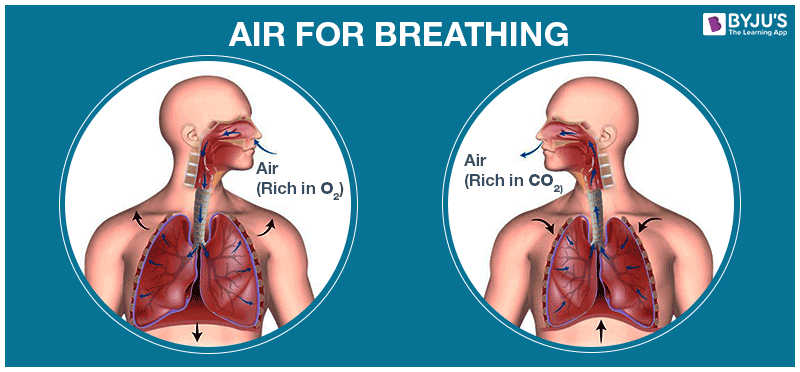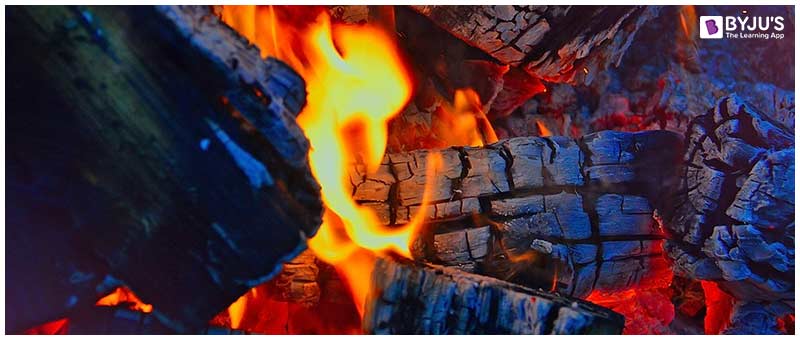The air around us forms the atmosphere of the earth. It extends from the ground to about 11 km into space. It gets denser due to gravity as we approach the ground. It has the right amount of pressure and composition to sustain life. The atmosphere above the earth’s surface forms a blanket of gases, protecting us from many harmful radiations that come from outer space. This part of the atmosphere is called the ozone layer.
Why is Air Important?
Air is a mixture of various gases found in the Earth’s atmosphere. Usually, the air is colourless, odourless and tasteless. It consists of about 78% nitrogen, 21% oxygen, 0.9% argon, 0.04% carbon dioxide, and trace amounts of other gases. Air plays a vital role in the existence of life on earth.
The three essential roles of air are as follows:
- Air for Breathing
- Air for Combustion
- Air for Regulating Temperature
Air for Breathing

Air contains two essential components: Oxygen and Carbon dioxide, which makes life possible. Oxygen is required by plants and animals to convert the chemical energy stored in food into energy that they can use for various metabolic processes.
During the process of respiration, oxygen in the air reacts with molecules from food to produce energy. In the process, carbon dioxide is released.
Plants consume carbon dioxide. During the day time or in the presence of sunlight, all green plants convert light energy into chemical energy. In this process, plants convert the carbon dioxide molecule into glucose (food) molecules, and oxygen is released as a byproduct. This process is known as photosynthesis.
Thus, we need air to gain energy from food and plants need it to store energy in the form of food. This balance sustains all life on earth.
Air for Combustion

What is Combustion?
Combustion is a chemical process in which, the fuel combines with oxygen gas to release energy in the form of heat and light. This heat can be used to produce electricity, run our cars and also for cooking.
During combustion, oxygen in the atmosphere combines with the carbon atoms to produce carbon dioxide and hydrogen atoms to produce water. In fact, without oxygen, one cannot use these fuels for our daily needs. However, too much oxygen can cause uncontrolled burning and explosions. Even the tiniest spark can set off fires.
However, this does not happen because of the presence of nitrogen gas in the atmosphere. Nitrogen does not support combustion and thus prevents the excess reactivity of oxygen.
Thus, these two components are essential to ensure that energy from the fuel can be used in a controlled manner.
Air for Regulating Temperatures
Upon heating, the density of air reduces, and it rises upwards. Similarly, cold air is denser than the hot air which sinks towards the ground. As the hot air rises, it creates a space of low pressure where the cold air rushes in and occupy this space. Winds are formed due to this phenomenon.
As the temperature of air increases, it raises up. The colder air from the surroundings enters into it, get heated up, and the cycle repeats. The rising of the hot air transfers its heat into outer space and sinks back down. In this way, heat is transferred from hotter regions to colder regions. This is known as temperature regulation, and the process of transferring heat is called convection.
Without the atmosphere, the daytime temperatures on earth would be extremely high and night time temperatures would dip below freezing. Thus, the air (through the greenhouse effect) would act like a blanket, providing a layer of insulation for life on earth.
Other natural resources like water, land, rivers, and mountains play a key role in sustaining life on earth by providing a sustainable environment for life. Essentially, life cannot survive without these vital components.
To learn more about nature, the air, different components of nature required for sustaining life on earth, register at BYJU’S.
Frequently Asked Questions
1. Is breathing combustion?
From a biological perspective, breathing resembles combustion, where chemical bonds are broken down and oxygen is used up; which then produces carbon dioxide.
2. Is air needed for life?
One of the most integral components of air is oxygen, which is important for all life on earth. However, certain microorganisms can survive without this element. These organisms are called anaerobes.
3. Which gas is essential for burning and breathing?
Oxygen is crucial for burning and combustion. It is also important for breathing.
4. What is the scientific name for air?
Technically, “air” does not have a scientific name as it is a mixture of substances. Chemical names can be given to “pure” substances such as water (H20) and oxygen (O2).
5. Why is air called the “breath of life?”
Air contains oxygen, which is the most important element for all life on earth.


Comments